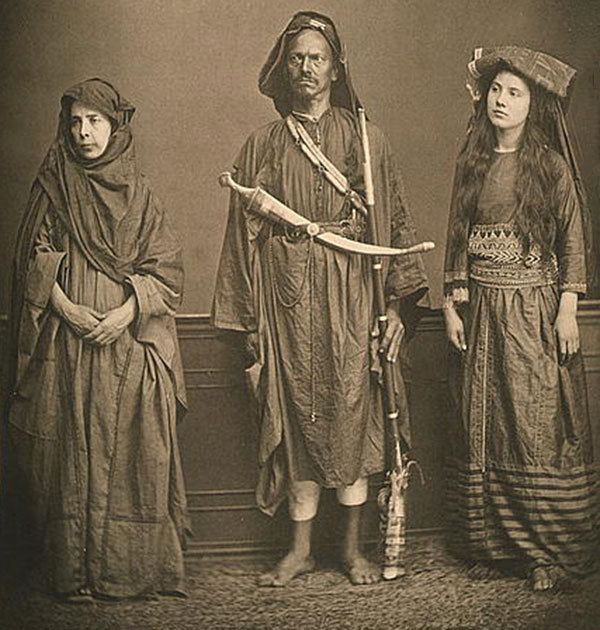Died 525 AD | ||
 | ||
Dhu nuwas
Dhū Nuwās, (Arabic: ذو نواس) or Yūsuf Ibn Sharhabeel (Arabic: يوسف بن شرحبيل) Syriac Masruq; Greek Dounaas (Δουναας), was a Judaic warlord in Yemen between 517 and 525-27 CE, who came to renown on account of his military exploits against people of other religions living in his kingdom.
Contents
Origins
Ibn Hisham's Sirat Rasul Allah (better known in English as the Life of Muhammad), describes the exploits of Yūsuf Dhū Nuwās. Ibn Hisham explains that Yūsuf was a Jew who grew out his sidelocks (nuwas meaning, "forelock" or "sidelock"), and who became known as "lord of the sidelocks." The historicity of Dhū Nuwās is affirmed by Philostorgius and by Procopius (in the latter's Persian War). Procopius writes that in 525, the armies of the Christian Kingdom of Axum in Ethiopia invaded Yemen at the request of the Byzantine Emperor, Justin I, to take control of the Jewish kingdom in Ḥimyar, then under the leadership of Yūsuf Dhū Nuwās, who rose to power in 522. Ibn Hisham explains the same sequel of events under the name of "Yūsuf Dhū Nuwās." Indeed, with this invasion, the Ḥimyarites were smitten, and as such the supremacy of the Jewish religion in the Kingdom of Ḥimyar, as well as in all of Yemen, came to an abrupt end.
Imrū al-Qays, the famous Yemeni poet from the same period, in his poem entitled taqūl lī bint al-kinda lammā ‘azafat, laments the death of two great men of Yemen, one of them being Dhū Nuwās, whom he regards as the last of the Himyarite kings:
"Art thou not saddened how fate has become an ugly beast, / the betrayer of its generation, he that swalloweth up people? It has removed Dhū Nuwās from the fortresses / who once ruled in the strongholds and over men / [An armored knight, who hurriedly broke the ends of the earth / and led his hordes of horse unto her uttermost parts And has shut up a dam in the place of the sunrise / for Gog and Magog that are (as tall as) mountains!]"One Syriac source appears to suggest that the mother of Dhū Nuwās may have been herself a Jew hailing from the Mesopotamian city of Nisibis. If so, this would place her origins within the Sassanid imperial sphere, and would illuminate possible political reasons for his later actions against the Christians of Arabia, who were natural allies of the Byzantine Empire. Many modern historians, though Christopher Haas is an exception, have argued that her son's conversion was a matter of tactical opportunism, since Judaism would have provided him with an ideological counterweight to the religion of his adversary, the Kingdom of Aksum, and also allowed him to curry favour with the Sassanid shahanshah.
His Rule
According to Ibn Ishaq, the king of Himyar named Dhu Nuwas had burned the Christians in Najran, and an invading army from Aksum (Habashah) occupied Yemen. Dhu Nuwas decided to kill himself by drowning himself in the sea. Arab tradition states that Dhū Nuwās committed suicide by riding his horse into the Red Sea. The Himyarite kingdom is said to have been ruled prior to Dhu-Nuwas by the Du Yazan dynasty of Jewish converts, as early as the late fourth century.
According to a number of medieval historians, who depend on the account of John of Ephesus, Dhū Nuwās announced that he would persecute the Christians living in his kingdom because Christian states persecuted his fellow co-religionists in their realms; a letter survives written by Simon, the bishop of Beth Arsham in 524 CE, recounting Dimnon (who is probably Dhū Nuwās') persecution in Najran in Saudi Arabia.
Based on other contemporary sources, after seizing the throne of the Ḥimyarites in ca. 518 or 523 Dhū Nuwās attacked the Aksumite (mainly Christian Ethiopians at Najrān, capturing them and burning their churches. After accepting the city's capitulation, he massacred those inhabitants who would not renounce Christianity.
According to the Arab historians, Dhū Nuwās then proceeded to write a letter to the Lakhmid king Al-Mundhir III ibn al-Nu'man of al-Ḥīrah and King Kavadh I of Persia, informing them of his deed and encouraging them to do likewise to the Christians under their dominion. Al-Mundhir received this letter in January 519, as he was receiving an embassy from Constantinople seeking to forge a peace between the Roman Empire and al-Ḥīrha. He revealed the contents of the letter to the Roman ambassadors who were horrified by its contents. Word of the slaughter quickly spread throughout the Roman and Persian realms, and refugees from Najran even reached the court of the Roman emperor Justin I himself, begging him to avenge the martyred Christians.
Quranic texts
Surat al-Fil (The Elephant) alludes to the Christian Abyssinian fate in Arabia and their military campaign against Mecca in the year 570 of the Christian Abyssinians era. Abrahah, the Christian conqueror of the Yemen (which at that time was ruled by the Abyssinians), built church at Sana'a, hoping thus to divert the annual Arabian pilgrimage from the Meccan sanctuary, the Kabah, to the new church. When this hope remained unfulfilled, he determined to destroy the Kabah; and so he set out against Mecca at the head of a large army, which included a number of war elephants as well. Abrahah's army was totally destroyed on its march - by stones of Sjeel (حجارة سجيل) according to verses mentioned in the Koran.
